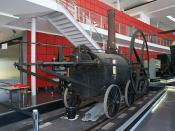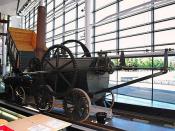When one considers the many technological achievements of mankind, few people can match those of Richard Trevethick (See Appendix 1). He was a pioneer of the Industrial Revolution and undoubtedly one of the greatest engineers to have ever lived. The range and magnitude of his inventive genius is truly astounding, and yet few outside Cornwall are aware of the immense contribution he made to the development of the modern world (See Appendix 2).
Born on April 13, 1771 in Cornwall, England (See Appendix 3), Trevethick was the first to successfully harness high-pressure steam. Trevethick constructed the world's first steam railway locomotive in 1803. In 1805 he adapted his high-pressure engine to driving an iron-rolling mill and to propelling a barge with the aid of paddle wheels.
Trevithick spent his youth at Illogan in the tin-mining district of Cornwall and attended the village school. The schoolmaster described him as "disobedient, slow and obstinate."
His father, a mine manager, considered him a loafer, and throughout his career Trevithick remained scarcely literate. Early in life, however, he displayed an extraordinary talent in engineering. Because of his intuitive ability to solve problems that perplexed educated engineers, he obtained his first job as engineer to several Cornish ore mines in 1790 at the age of 19.
The constant need, in the eighteenth century to keep the ver deepening mines in Cornwall dry made it necessary to employ the beam engines of Newcomen and latterly the more efficient engines of Boulton and Watt. They were monstrous stationary machines, which were very expensive to erect each requiring an immense masonry engine house and stack, a separate boiler and a reservoir to maintain a constant water supply.
Boulton and Watt held very restrictive patents, which effectively gave them a monopoly on the supply of steam engines for...


